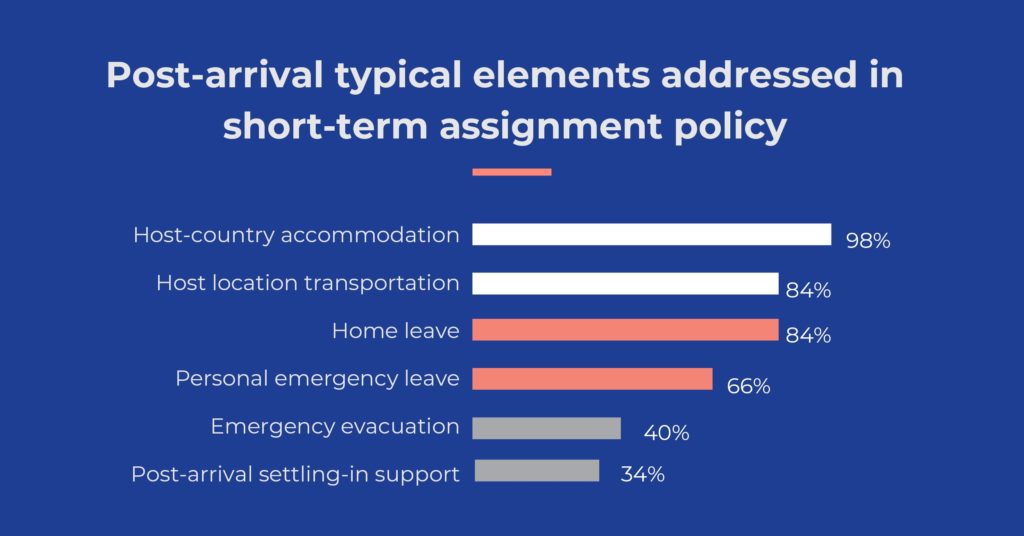Short-term assignments (STAs) continue to be a popular option for global mobility and are quickly evolving into an ED&I Mobility vehicle. These opportunities have the potential to allow more diverse employee populations to gain experiences that will enhance career paths and diversify an organization’s leadership pipeline. This makes it more important than ever to ensure STA policy lines up with typical practices.
We’ve studied the STA policies of 62 companies to discover overall trends as well as notable differences in how companies address assistance for this move type. Here are the top 10 takeaways from our latest report:
- 68% of policies are from EMEA-based companies. This predominance reflects the use of STAs globally.
Given the geography of the EMEA region (vs North America), STAs are a realistic option for many reasons that companies transfer employees (e.g., skill development, filling a position gap, etc.). - Half of the policies specify that STAs are unaccompanied, typically attributed to the limited assignment duration, which most commonly ranges from three (62%) – twelve (83%) months.
- Some elements of STA policy are similar to their counterparts in long-term assignment (LTA) policy:
- Immigration assistance (addressed in 89% of STA and LTA policies).
- Travel to the host location (87% of STA policies vs 92% of LTA policies).
- Cultural training (61% STA vs 67% LTA).
- Language training (61% STA vs 78% LTA). Just as in LTA policy, the use of cultural and language training typically requires approval.
- 90% of policies address health insurance for short-term assignees. It is becoming common to provide an international program for short-term assignees, as stated in 41% of policies (55% use this approach for LTAs).
- 34% of STA policies address settling-in assistance, compared to 46% of LTA policies. Assistance typically focuses on single assignees who are in country for a limited duration that might require: assistance with establishing a bank account, locating shopping facilities, public transportation, local services, religious institutions, and social opportunities.
- Home leave is addressed in 84% of STA policies (vs 90% of LTA policies). The major difference is the timing of the trips. For STAs, the most common frequency is one trip every three months (33%). Though many policies vary frequency based on assignment circumstances such as duration, accompaniment status, or distance between the home and host country.
- Interestingly, more STA policies (84%) address host location transportation than LTA policies (78%). Both most commonly state that assistance is based on host location transportation conditions and local company practices (61% for STAs and 73% for LTAs).

- STA policy rarely includes the shipment of household goods; rather, most (52%) assist with an air shipment of personal effects or excess baggage charges only (30%).
- Few (23%) provide a pre-move trip.
Primarily because most (72%) provide furnished accommodations rather than have the employee find their own housing. - Fewer (47%) provide temporary living for STAs than the 98% that address it in LTA policies.
- It is not as common to provide a hardship allowance for STAs (32%) as it is for LTAs (53%).
- Use of a relocation allowance is not as common for STAs as it is for LTAs: 47% vs. 84%, respectively.
- Most companies (63%) retain employees on their home country compensation and provide a per diem or reimbursement for daily living expenses while on an STA.
The lower cost profile of short-term assignments – due to single status, shorter duration, simpler support – continues to contribute to the popularity of this move type. For companies reviewing their STA policies, it can be very beneficial to see what the typical practices are and how they differ from their LTA counterparts.
Five common myths about short-term assignments
Myth #1: An STA is pretty much the same as an LTA – just shorter.
Fact: The differences between these two assignment types are notable and significant. Long-term assignments are typically investments in the future. Their considerable use of resources (people and money) makes them worthwhile for business-building initiatives such as leadership training, market expansion, management roles where local candidates are not available and new product development. These are all goals that require a long term to complete. Short-term assignments are better suited to initiatives that can be completed in under a year. Global exposure, filling a job gap, short-term projects and skill building are examples of realistic STA assignment objectives.
Myth #2: Employees on short-term assignments need less support than those on long-term assignments.
Fact: Replace “less” with “some of the same but also different” and you would be correct! For example, short-term assignees need assistance with some of the same things as long-term assignees (immigration and tax compliance, travel, arranging housing, becoming familiar with the assignment location, etc.). But they also need different things, given that most short-term assignees remain on home-country compensation and retain many home-country expenses. For example, they need a per diem to cover daily living costs in the host location. Since many STAs are single-status, employees may have left immediate family in the home location. Therefore, trips home are a greater need for STAs than they are for LTAs.
Myth #3: It sounds like an STA is really just a glorified business trip.
Fact: Aside from the primary distinction that a business trip is typically no more than a month and an STA is typically 3-12 months, the business objectives are different, too. This is a key issue.
A business trip is more like a drop-in program, where the goal is of an immediate nature, such as to share information, visit a customer, teach a skill, lead training, etc. An STA typically requires an employee to adjust to a local culture and style-switch more than a business trip does. They may need to work closely with a team, impart knowledge over time or fill in for a temporarily out-of-the-office colleague. Further, someone living in an area for up to a year is likely to require more of a “real life” outside of work rather than using free time as a tourist and ordering room service. This greater integration into the host location makes an STA more like an LTA than a business trip.
Myth #4: Short-term assignees don’t need the same cultural or language training as long-term assignees.
Fact: The fact that short-term assignees need to quickly get up and running, live in the local area and succeed in the business environment often dictates that they require the same or similar training as long-term assignees. Of course, there are times when a short-term assignee is needed for work that is primarily solitary and does not require local language skills. In this case, more condensed training may be sufficient.
Myth #5: We should be more concerned about the challenges of long-term vs. short-term assignments, given their bigger goals, longer time in the host country and greater cost to the company.
Fact: STAs may impact a more diverse pool of employees than LTAs do. Companies may not recognize the challenges different demographics may encounter on STAs as they do for LTAs. For example, an employee may turn down an LTA because a same-sex partner cannot accompany but that employee may undertake an STA single-status. However, that employee still needs to be successful in the local environment. Similar ED&I considerations may be necessary for many populations (women, younger employees, older employees, etc.). It is important to address the same factors for these employees on STAs as one would if they were embarking on an LTA.
To benchmark your STA policy and discover more emerging trends, download our 2022 expert report here.
If you have any questions regarding this article or would like to find out more about other services, please contact Lisa Johnson (Global Practice Leader, Consulting Services) at ljohnson@crownww.com.




